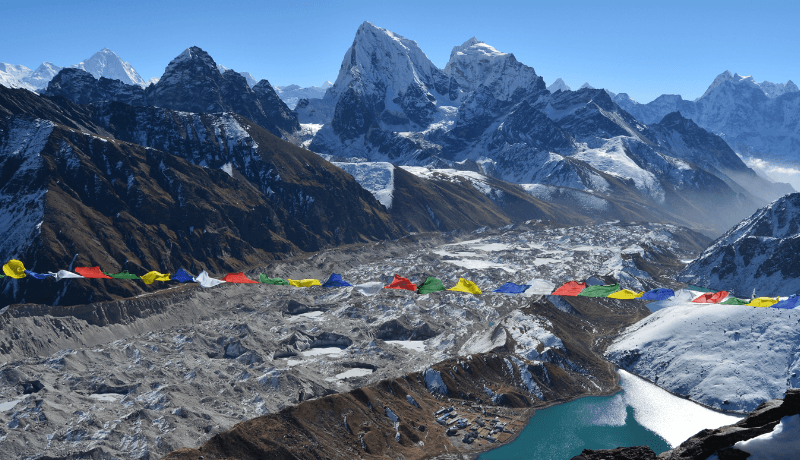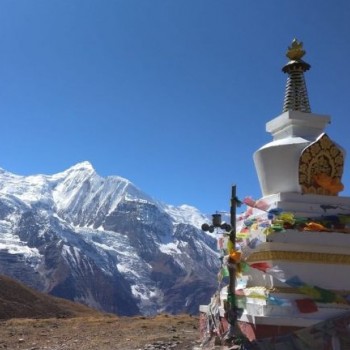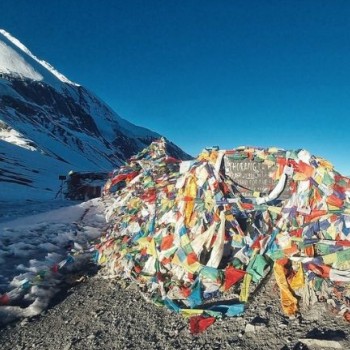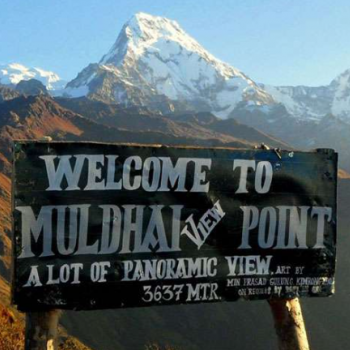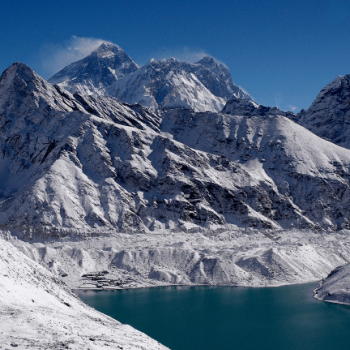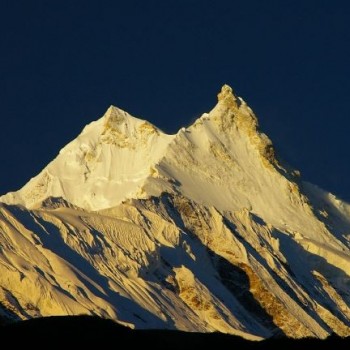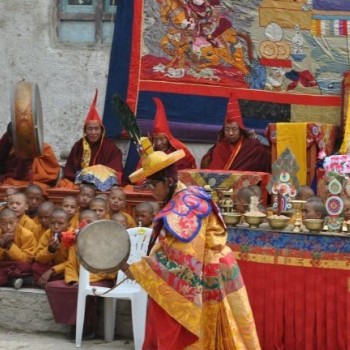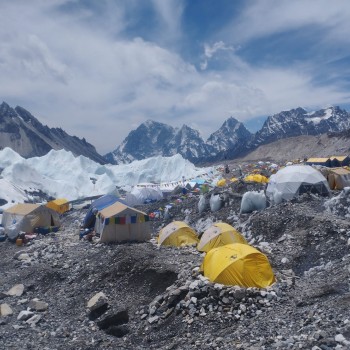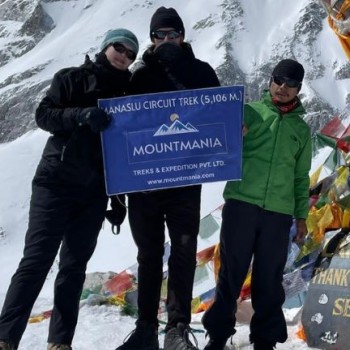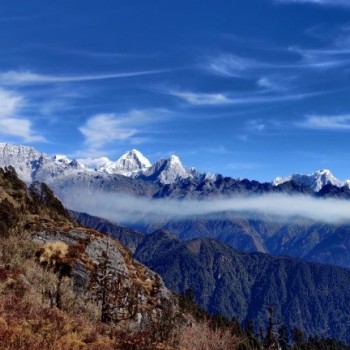Trip Details
Destination: Nepal
Trip Difficulty: Very Strenuous
Trip Style: Active Adventure
Transport: Private Vehicle & Flight
Food: Breakfast, Lunch & Dinner
Accommodation: Teahouse or Lodge
Group Size: 1 - 16
Max Elevation: 6189m island peak
Highlights
- Cross 3 mountain passes of the Everest region.
- A thrilling flight to Lukla.
- Explore the mountaineering museum in Namche Bazaar.
- Visit the largest monastery in the Everest region- Tengboche Monastery.
- Astonishing views of the Khumbu and Ngozumpa glacier from EBC.
- Trek to the Base Camp of the tallest mountain in the world.
- Visit the highest freshwater lake system in the world- Gokyo Lakes.
- Mesmerizing sunrise views from Kala Patthar.
- Summit the Island Peak (6189m)
- Island Peak Base Camp (Pareshaya Gyab)
- Island Peak also is known as Imja Tse
- Imja Tsho (5010m)
- Amphu Labste Tsho (4985m)
- Good view of Mt. Ampulapcha (5663m), Mt. Makalu (8481m), Mt. Ama Dablam (6812m)
- Lhotse Glacier
Description
Everest Three High Passes Trek with Island Peak Climbing – Overview
Embark on the ultimate Himalayan adventure—the Everest Three High Passes Trek combined with Island Peak Climbing—a journey designed for true mountain lovers and thrill-seekers. This challenging yet breathtaking trek takes you across three of the highest and most iconic passes in the Khumbu region: Renjo La (5,446m / 17,520ft), Cho La (5,420m / 17,782ft), and Kongma La (5,535m / 18,159ft). To top it off, you’ll summit the majestic Island Peak (6,189m), one of Nepal’s most popular trekking peaks.
This expedition offers unrivaled panoramic views of some of the world’s highest mountains, including Everest, Lhotse, Nuptse, Makalu, Pumori, Ama Dablam, Cholatse, and Khumbutse. The dramatic landscapes of glaciers, high-altitude passes, and snow-capped peaks will leave you in awe at every step.
Our trail winds through picturesque Sherpa villages, where you'll witness the rich culture, age-old traditions, and spiritual heritage of the Himalayan people. Visit ancient Buddhist monasteries, spin prayer wheels, and walk beneath fluttering prayer flags that color the landscape with meaning. The route also passes through Sagarmatha National Park, a UNESCO World Heritage Site teeming with unique Himalayan wildlife such as musk deer, Himalayan tahr, blue sheep, blood pheasants, and Tibetan snow cocks.
At Mount Mania Treks & Expedition, we offer this Three High Passes Trek with Island Peak Climbing as one of our best-selling packages, combining both teahouse trekking and camping. Our experienced team of Sherpa guides and porters are dedicated to your safety and comfort, ensuring a memorable journey that meets your needs and expectations.
Island Peak, nestled in the stunning Chhukung Valley, is a striking glaciated peak rising proudly above the Lhotse Glacier. While the climb demands physical effort and basic mountaineering skills, the reward is unmatched—sweeping views of Everest, Makalu, Lhotse, and more from the summit.
Cost for Everest Three High Passes Trek with Island Peak Climbing – 2025 & 2026 Mount Mania Treks & Expedition offers competitive pricing for this adventure, with costs based on group size and booking period for 2025 and 2026. Contact us for the latest rates and group discounts.
Route Description
The trek begins with a scenic flight from Kathmandu to Lukla, a small mountain town that serves as the gateway to the Everest region. From Lukla, the trail leads to Phakding, then ascends to Namche Bazaar, the bustling Sherpa capital. The route continues through Thame, Gokyo, and Gorak Shep, culminating at Everest Base Camp. Afterward, trekkers cross three high passes— Renjo La (5,360m), Cho La (5,420m), and Kongma La (5,535m), before reaching Chhukung, the base for Island Peak climbing.
Island Peak (Imja Tse), standing at 6,189 meters, is a non-technical peak that offers a thrilling climbing experience. The ascent typically begins in the early hours to reach the summit by sunrise, providing panoramic views of Mount Everest, Lhotse, and other towering peaks.
Major Attractions Along the Route
1. Lukla
Lukla is the starting point for most treks in the Everest region. The town is known for its small airport with a short runway, making the flight from Kathmandu an exhilarating experience. Lukla offers various accommodations and serves as a hub for trekkers.
2. Namche Bazaar
Namche Bazaar is a vibrant Sherpa town known for its weekly Friday & Saturday market, were locals trade goods. The town offers stunning views of Everest and serves as an acclimatization point for trekkers.
3. Gokyo Lakes
The Gokyo Lakes are a series of turquoise glacial lakes situated at an elevation of 4,700 to 5,000 meters. The area is renowned for its serene beauty and is a haven for trekkers seeking tranquility away from the more crowded Everest Base Camp route.
4. Chola Pass
Chola Pass is one of the three high passes on this trek. At an altitude of 5,420 meters, it connects Dzongla and Thangnak. The pass is known for its challenging terrain, including glacier crossings and steep ascents.
5. Gorak Shep
Gorak Shep is the last settlement before Everest Base Camp. Situated at 5,164 meters, it serves as the final stop for trekkers heading to the base camp and offers a glimpse into the harsh conditions faced by mountaineers.
6. Kala Patthar
Kala Patthar, meaning "black rock," is a popular viewpoint located at 5,545 meters. It offers one of the best panoramic views of Mount Everest, including close-up views of the Khumbu Icefall and neighboring peaks.
7. Everest Base Camp
At an elevation of 5,364 meters, Everest Base Camp is the starting point for summit expeditions. Trekkers visit the base camp to experience the base of the world's highest mountain and to witness the challenging environment faced by climbers.
8. Chhukung
Chhukung is a small village situated at 4,730 meters. It serves as the base for Island Peak climbing and offers stunning views of the surrounding peaks. Trekkers often spend a day here to acclimatize before the ascent.
9. Island Peak
Island Peak, or Imja Tse, is a non-technical peak that stands at 6,165 meters. The climb involves glacier travel, ice climbing, and a summit ridge that offers breathtaking views of the surrounding mountains.
Physical Preparation
Trekking Difficulty
The Everest Three Passes Trek combined with Island Peak climbing is a strenuous journey that involves long days of trekking at high altitudes. The route includes challenging terrain, steep ascents, and glacier crossings. Proper physical conditioning is essential to undertake this adventure.
Training Regimen
A comprehensive training program should include:
- Cardiovascular Endurance: Engage in activities like running, cycling, or swimming to improve heart and lung capacity.
- Strength Training: Focus on exercises that build leg strength, such as squats, lunges, and step-ups.
- Hiking Practice: Simulate trekking conditions by hiking on varied terrains with a loaded backpack.
- Flexibility and Balance: Incorporate yoga or stretching routines to improve flexibility and balance.
- Altitude Acclimatization: If possible, train at higher elevations to prepare your body for the reduced oxygen levels.
Mental Preparation
Mental resilience is crucial for high-altitude trekking and climbing. Techniques to enhance mental strength include:
- Visualization: Envision yourself successfully completing the trek and summit.
- Mindfulness: Practice mindfulness to stay present and manage stress.
- Positive Affirmations: Use affirmations to build confidence and maintain motivation.
- Goal Setting: Set realistic and achievable goals for each day of the trek.
Essential Gear and Packing List for Everest Three Passes Trek with Island Peak Climbing
Embarking on the Everest Three Passes Trek combined with Island Peak climbing is an extraordinary adventure that demands meticulous preparation. The journey traverses rugged terrains, crosses high-altitude passes, and culminates in the ascent of Island Peak (Imja Tse) at 6,189 meters. To ensure safety, comfort, and success, a comprehensive gear list is essential.
Personal Documents and Essentials
- Passport: Valid for at least six months beyond your planned departure date.
- Nepal Visa: Obtainable upon arrival at Tribhuvan International Airport or in advance.
- Travel Insurance: Must cover high-altitude trekking and emergency evacuation.
- Cash: Sufficient Nepali Rupees for personal expenses; credit cards are not widely accepted on the trail.
- Photocopies: Copies of passport, visa, insurance, and emergency contacts.
Clothing
Layering is crucial for adapting to varying temperatures and conditions:
- Base Layers: Merino wool or synthetic thermal tops and bottoms.
- Mid Layers: Fleece or lightweight insulated jackets.
- Outer Layers:
- Waterproof and windproof shell jacket and pants (preferably Gore-Tex).
- Down or synthetic insulated jacket with a hood.
- Trekking Pants: Lightweight, breathable, and quick-drying.
- Summit Pants: Insulated and waterproof for high-altitude conditions.
Gloves:
- Lightweight liner gloves.
- Mid-weight trekking gloves.
- Summit mittens with safety straps.
Headwear:
- Balaclava or neck gaiter.
- Fleece hat.
- Wide-brimmed sun hat.
- Glacier sunglasses with UV protection (carry an extra pair).
- Headlamp with extra batteries.
Footwear:
- Double-layer insulated mountaineering boots for climbing.
- Waterproof trekking boots with ankle support.
- Gaiters to protect against snow and debris.
- Lightweight sandals or flip-flops for camp use.
- Wool or synthetic socks (5–6 pairs).
Backpacks and Duffels
- Daypack (30–40L): For daily essentials during the trek.
- Expedition Backpack (60–70L): For carrying gear between teahouses and camps.
- Duffel Bag (80–100L): For porters to carry; waterproof covers recommended.
- Waterproof Stuff Sacks: To keep gear dry.
Sleeping Gear
- Sleeping Bag: Rated for temperatures as low as -20°C to -40°C.
- Sleeping Pad: Inflatable or foam pad for insulation.
- Pillow: Compressible or inflatable for comfort.
Climbing Equipment
Island Peak climbing requires specific gear:
- Helmet: For head protection.
- Crampons: Compatible with mountaineering boots.
- Ice Axe: Optional but recommended for self-arrest.
- Harness: Lightweight and adjustable.
- Ascender (Jumar): For rope ascents.
- Carabiners: Locking and non-locking (2–3 each).
- Belay Device (ATC or Figure 8): For rappelling.
- Prusik Loops: For rope ascents.
- Tape Slings: For securing gear.
- Rope: Provided by the expedition team.
Hydration and Nutrition
- Water Bottles: At least 2 liters capacity; Nalgene or similar.
- Water Purification: Tablets or filter; essential for safe drinking water.
- Thermos: For hot beverages during cold mornings.
- Snacks: Energy bars, nuts, dried fruits, and chocolates.
- Eating Utensils: Spoon, fork, bowl, and mug.
Medications:
- Diamox (Acetazolamide) for altitude sickness prevention.
- Pain relievers (e.g., paracetamol, ibuprofen).
- Antibiotics (e.g., ciprofloxacin).
- Anti-diarrheal medication.
- Cold and cough medicine.
- Sunscreen: High SPF (50+).
- Lip Balm: With UV protection.
- Toiletries: Toothbrush, toothpaste, biodegradable soap, and wet wipes.
- Hand Sanitizer: For hygiene.
- Feminine Hygiene Products: As required.
- Earplugs: For sleeping in shared accommodations.
Miscellaneous Items
- Camera: With extra batteries and memory cards.
- Power Bank: For charging electronic devices.
- Notebook and Pen: For journaling.
- Binoculars: Optional, for wildlife and scenery viewing.
- Repair Kit: Duct tape, multi-tool, and spare parts.
- Trash Bags: To pack out all waste.
- Adapter: Type C for Nepalese sockets.
- Trekking Poles: Adjustable and foldable for stability.
Optional Items
- Reading Material: Books or e-reader.
- Playing Cards: For entertainment during rest periods.
- Swimsuit: If accommodations have hot tubs or pools.
- Travel Towel: Quick-drying and compact.
Note: Many trekking and climbing items, such as down jackets, sleeping bags, and climbing boots, can be rented or purchased in Kathmandu. However, it's advisable to bring personal items like base layers, gloves, and socks to ensure comfort and hygiene.
Proper preparation and the right gear are vital for a successful and enjoyable Everest Three Passes Trek with Island Peak climbing. Ensure all equipment is tested and well-fitted before departure to minimize issues during the expedition.
FAQs
What is Trekking, and how it is different than Hiking and Climbing?
Trekking is an activity of walking the natural landscapes (especially the side of the mountain) with a specific purpose of exploring and enjoying the scenery. Trekking is generally a multi-day walk, where you stay overnight at trails.
It tests the trekker's physical ability, stamina, endurance, and also the psychological capacity. Trekking is different from hiking as trekking is a rigorous and challenging activity, whereas hiking is mainly a leisure activity. Hiking generally ranges from a single day walk.
Climbing, on the other hand, is a much more challenging that requires various technical skills like abseiling, rope fixing, among others. A climber is much riskier requires specialized equipment, as well as rigorous training.
How many hours should I walk daily?
The trekking hours depend upon the trekking routes you choose. In general, a trek like Everest Base Camp, Annapurna Circuit, Manaslu Circuit, Annapurna Base Camp, Kanchenjunga treks requires five to six hours of walking on average. The duration also depends on your pace too.
It is not advisable to trek more than 600m altitude in a day. Starting your trek early is key to avoiding the midday heat and arriving at your destination early. This leaves you enough time to rest, acclimatize, and explore the region.
How difficult is trekking in Nepal?
The level of difficulty depends on the trekking route such as Everest region treks, Annapurna region treks, and other remote area treks. It is also subjective to each individual and their level of endurance. A basic level of fitness is necessary to trek the high altitude region of Nepal with considerably challenging trails.
Also Read: Manaslu Circuit Trek Difficulty
Some regular exercise, including cardiovascular activities including but not limited to hiking, cycling, swimming, is a must. Trekkers must have a healthy heart, lungs, and joints. You must start the training regime at least two weeks before the trek.
Is Trekking recommended for all age groups of travelers?
Trekking in Nepal is ideal for all age groups. Trekking can be fun for children as well as for people in their seventies. You can choose the trek based on the difficulty level and suitability.
However, with children, you need to be extra careful in the high altitude regions as they cannot express their pain and fatigue properly. For older people, treks can get customized with accommodating enough rest, acclimatization, and cultural exploration.
You can opt for Ghorepani Poon Hill trek, as it is one of the most popular easy treks in Nepal. This trek is suitable for all age groups with children and family as well.
Also Read: Top 10 Best Short Treks in Nepal
What is the minimum duration for trekking?
The minimum duration of trekking depends upon the trek destination and trail type. There are many treks that last around 3-8 days.
These treks are short and specially designed for beginners. The trek journey can get modified by increasing or decreasing the rest and acclimatization days.
Do I need to get some training before doing trekking in Nepal?
Yes, it's better to get some training before doin trekking in Nepal. The training should consist of practice hikes, cardiovascular endurance (aerobic exercise), strength training, and mental strength exercises.
What are the basic tips for beginner trekkers who don’t have any experience?
The essential tips for beginners trekkers who don't have any experience are:
- Walk at a slow but steady pace
- Do not rush in your trek
- Acclimatize and hydrate regularly
- Pack all your necessities properly
- Start early on your trek
- Pre-book your trip
How safe is the water to drink?
The tap water in Nepal is unsafe to drink. The trekkers need to boil their water, use water purification tablets, or bottled water. In high altitude conditions, you need to boil water longer than at lower elevations.
If you choose to carry or buy bottled water, you should always check if the bottle cap is properly sealed and not tampered. Water purification tablets and drops like Piyush, Water guard use chlorine solution to purify waters.
You can use any of these methods and drink lots of water to reduce dehydration and cope with altitude sickness.
Where are we staying each night during trekking?
Nepal is famous for the teahouse treks. There are tea houses, lodges, guest houses all along the trails. You will stay at these accommodations each night on your trekking adventure.
These accommodation facilities provide twin beds, a pillow, and a warm fuzzy blanket. You might find it challenging to find proper accommodation facilities along with the remote off the beaten treks. You might have to camp in such conditions.
What is Teahouse Trekking Nepal?
The teahouses trekking means staying in a teahouse or lodge every night in your trekking journey. The tea houses offer necessary facilities of lodging and meal and allow trekkers to carry a minimum amount of gear.
A teahouse can range from comfortable lodges, like in the Solu Khumbu region to a small bamboo hut in the remote trails of western Nepal.
Which are the permits required for trekking? Can I apply as an individual?
A TIMS (Trekkers’ Information Management Systems) card is a necessary trekking permit required for any trekking activity in Nepal. Besides that, you will need area-specific trekking permits at varied costs based on the region.
For example, you will need an ACAP (Annapurna Conservation Area Permit) if you want to do the Annapurna Circuit trek permit and a Sagarmatha National park permit for the EBC trek. You can get the TIMS card and other area-specific permits at the office of the Nepal Tourism Board office in Kathmandu.
Is Travel Insurance compulsory while you travel to Nepal?
Yes, travel insurance is compulsory for all travelers traveling to the region. You must get an excellent travel insurance package that covers both the medical and emergency evacuation cost. A travel insurance package of a minimum of USD 100,000 is ideal.
What if I get sick in the mountains?
When trekking in the remote mountain areas, you will only get elementary medical facilities available or none at all. You can find the Himalayan Rescue Association (HRA) health posts run by western volunteer doctors at Pheriche and Manang in the Everest and Annapurna region, respectively.
The doctors provide consultation and services if necessary. If you get severely ill or accidents, then you might as well need a helicopter evacuation back to Kathmandu or Pokhara.
How high is the chance to get altitude sickness? How will a guide help?
The chance to get altitude sickness is exceptionally high in these Himalayan regions. A guide will help you to acclimatize appropriately, which is a crucial step to avoid altitude sickness. The guide can also help you to recover in case you get altitude sickness or with any emergencies.
How to avoid altitude sickness?
The primary key to avoid altitude sickness is to acclimatize properly. You should not gain more than 600m in altitude in the high altitude regions. Expert trekkers advise to take it slow and not to trek in a rush.
Regular hydration with at least 5 liters of water is a must. You can also take precautionary tablets under the supervision of a medical professional if needed.
Why is the domestic flight specially to and from Lukla or Jomsom delayed?
The domestic flight to and from Lukla gets delayed frequently due to unfavorable weather conditions. The weather around the high altitude regions is quite unpredictable.
Lukla airport is also one of the smallest airports in the world. The short runway means that multiple flights cannot land at the same time and can even cause unwanted delays.
Who will carry my backpack?
You can hire a porter for the high altitude trek. They will carry all your luggage that might include your trekking and sleeping equipment. Hiring a porter significantly reduces the weight off your back.
You can carry a light daypack consisting of water, a camera, snacks, and rain gear. The heavy luggage will get carried by a porter. Some guides work as porters, as well.
What are the food items that we can eat in the teahouse?
For breakfast, the tea houses provide a regular bread toast along with hot tea or coffee. For lunch and dinner, the staple dish of “Dal Bhat” gets served on the tea houses. The Dal Bhat is highly nutritious, with a balance of carbohydrates and protein.
It consists of if rice, cereal, vegetables, lentils, spinach, meat, and pickles. Some tea houses do serve a limited variety of western cuisines like pizza, burgers, and pasta, as well.
What are the services that we get from each teahouse?
The tea houses provide lodging and meal facilities. They provide a twin bedroom with a pillow and a fuzzy blanket. You will have to share a shared bathroom with fellow trekkers. The toilets are generally of squat style.
Besides that, you will get all the meal facilities in the tea houses as well. You can get all the meals of the day i.e. breakfast, lunch, and dinner in the tea houses. The food might not be fancy but provides you with excellent nutrition and adequate energy for the trek.
How safe is Nepal for solo woman traveler?
Nepal is generally safe for women travelers. The Nepalese society is quite conservative and has a specific idea of modest clothing. Dressing modestly by covering thighs and shoulders will save you from unwanted gaze on the streets.
Female travelers should not travel alone, especially at late nights. You should also choose your guide wisely after a thorough background check. If you keep these things in your mind, you will remain safe while traveling in Nepal.
How much money should I bring for trekking?
A general estimate of $25 per day per person on average would be enough for trekking in Nepal. The food and accommodation costs are generally paid upfront and costs around $2 - $3 per bed. This also includes the food costs that are available provided in the teahouses.
If you wish to take hot water showers or recharge electronic gadgets, it might cost you a couple of bucks more. If you are a budget traveler, spending frugally might get the costs down to $15. Overall, the rough estimate of $25 is ideal for the trek.
Are there any ATMs on the way to trekking routes?
There are no ATMs along the trail in the high altitude region. The last ATM can is in Namche and Lukla if you are trekking the Everest Base Camp region. You will have to use the ATM in Kathmandu and Pokhara and carry the necessary cash along with you in the trek.
How much weight can one porter carry?
A porter generally carries 10kg per client, and they carry for two clients, which means they can carry a maximum of 20kg. However, it is advisable to reduce the amount of luggage and only take the necessary ones.
How many tips should we give to guide and porter?
The general unwritten but widely followed rule is to tip 15 percent of the total cost spent trekking. If you are trekking solo, the rule of thumb is to tip $5 per day or equivalent for guides and $2 to $4 per day or equivalent for porters.
For group trekking, you can tip $10 per day for guides and $5 per day for porters. You can also tip as you wish based on the weight carried and the service provided.
What are the best seasons for trekking in Nepal?
The best time for trekking is the Spring (March to May) and Autumn (September to November). During spring, wildflowers, including rhododendrons bloom all over the trails. The clear skies and stable weather is the major attraction of the trek.
The autumn months of September to November is famous for its soothing climate and favorable temperatures. In addition to these perks, autumn is also a festive season with vibrant festivals Dashain and Tihar falling at this time of the year.
The monsoon and the winters are generally avoided because of the risks and the challenges.
Also Read: Best Time to Visit Nepal
What are the basic criteria for physical fitness?
Many people assume that they need to have an athletic strength to complete treks in Nepal, which is not true. A basic level of fitness with good stamina can easily lead you to success in the trails of Nepal.
Some cardio (aerobic) exercises, including hiking, cycling, swimming, tai chi, etc. can help you gain fitness before the start of your trek. One important thing to consider is that the treks are not a race, so you need to maintain a gentle pace with sufficient breaks and acclimatization.
If your fitness levels are on the higher side, you will enjoy the treks more and find more energy for extra activities.
Can I do trekking solo without a guide and porter?
Yes, you can trek solo in Nepal without a guide or a porter on many routes. If you come well prepared with a map or traveling a well-trodden path, you can trek pleasantly in solitude.
However, some restricted trails like Manaslu Circuit Trek do require a guide by compulsion. But there are risks of traveling without a guide mostly related to health issues and freak weather conditions.
Also Read: Manaslu Circuit Trek Without Guide
Can you list out the packing list for trekking?
The packing list for trekking in Nepal are as follows:
Clothing
- Trekking pants and jackets
- Rainproof pants and jackets
- Thermals underwear
- Pair of Gloves
- Short-sleeved trekking shirts
- Long-sleeved trekking shirts
- Woolen cap/ beanies
- Insulating jackets
- fleece-lined jacket
- Lightweight Sweaters
- Trekking boots
First Aid
- Band-aids
- Anti-nausea Medicines
- Sanitary pads/ Tampons
- Mosquito repellent spray or ointment
Toiletries
- Toilet Paper
- Shampoo
- Soap
- Sunscreen
- Hand sanitizer
Accessories
- Cameras
- Water Bottle
- Sleeping bag
- Sunglasses
- Chargers
- Extra Batteries
Important Documents
- Passport
- Photo
- Travel Permits
Can I recharge my camera batteries, phone, and other electronic batteries?
Yes, there are facilities for charging electronic gadgets like cameras, phones, and other electric batteries at an added cost. However, the charges are on the higher side, and charging time gets limited. Hence, carrying a solar-powered charger or power bank is a good option.
Can I get trekking gears and equipment on rent?
Yes, you can get any trekking gears and equipment on rent. The famous street of Thamel in Kathmandu is popularly known as “backpacker’s alley.” You can get all kinds of trekking gears and equipment, including sleeping bags, down jackets, trekking boots, for rent.
There are many gears of knock-off brands that work surprisingly well. But you should always stay away from substandard stuff that might cause you nuisance along the trek.
Is laundry services available in teahouse?
There are a few laundry services available in places like Namche. However, in the high altitude region, these facilities get scarce. You will have to wash your clothes on your own in the sink. You can use a small amount of warm water to wash your clothes.
What is the weather like in Nepal?
There are five distinct seasons in Nepal. The summers are hot and wet, and the monsoons are wet with chances of landslides. The winters are cold with freezing temperatures in the high mountains. These seasons are not the best time to trek the region.
The peak trekking seasons in Nepal are the autumn and the spring season. The autumn months come after the monsoon, and thus trekkers can enjoy the stable weather with perfect trekking temperatures.
The spring is when the trails look its best. The beautiful wildflowers, including rhododendron bloom all over the trails and the scenic environment, makes the trek quite pleasant.
What types of trekking shoes or boots do I need to bring?
You will require waterproof, sturdy hiking boots for trekking the Himalayas in Nepal. There are various shops in and around Thamel in Kathmandu that lets you buy or rent specialized trekking shoes.
Trekkers do not necessarily require crampons, but if you are trekking on a snowy trail, crampons fitted trekking boots helps you get past the snow with ease.
How will the travel company solve the problem in case of an emergency?
The guides and porters are adequately trained and skilled in handling emergencies. The travel agency is in communication with the team leader at all times through a mobile or a satellite phone.
You will get immediate first aid and all necessary help if required. Helicopters are at standby positions in case the conditions get worse, and you need an emergency helicopter evacuation.
Are there any other outdoor activities besides trekking in Nepal?
Nepal is an adventure-lovers delight. There are many outdoor activities, including bungee jumping, paragliding, zip-lining, rafting, rock climbing, canoeing, jungle safari, and others in Nepal. You can choose the best one according to your desire and schedule.
How expensive or costly is to do trekking?
While the cost may vary according to the trails, in general, the cost of trekking ranges around $1000-$2500 on average, excluding the international flight costs. This cost includes food, accommodation, permits, guide/porter, and other fees.
Which were the trekking routes damaged by an earthquake in 2015?
The popular routes Annapurna Base Camp trek and the Everest Base Camp trek was not much affected by the earthquake in 2015. However, the pristine Langtang and Manalsu trekking region were severely affected.
The landslide after the earthquake swept away many teahouses in the Langtang region, and more than 300 lives were lost. The quick rebuilding process led by the local community ensured that all the trekking routes get restored and repaired immediately.
These trails are safer than ever for a trekking adventure. Trekking has since resumed in the Langtang region.
Where the most popular places to do trekking in Nepal?
There are many trekking trails in Nepal. Some of the famous trekking trails include the Everest Base Camp Trek in the Everest region. The Annapurna Circuit trek in the tranquil Annapurna region is also quite popular.
The Upper Mustang trek, Manaslu trek, Langtang trek are also quite popular. Besides these, many off the beaten trekking routes are gaining popularity as well.
Does my guide carry a simple medical kit for general treatment?
Yes, the professional guides do carry a simple medical/ first aid kits. They are well trained and are adept at performing simple first aid if necessary. However, if the condition worsens, you will need professional medical help or even evacuation.
Do I need to carry a sleeping bag or not?
Although a warm blanket gets provided at the teahouses, carrying a sleeping bag is always a good option. The trails can get busy, and in freezing conditions, a single blanket might not be enough, and an extra blanket might not be available. Hence, a sleeping bag helps you get a good night's sleep after a long day of the trek.
What is the basic equipment do I need to bring for trekking?
The essential equipment you need to bring for trekking includes standard trekking gears and clothes, first aid kits, toiletries, and other accessories. The trekking gears and clothes include waterproof trekking jackets, sturdy boots, waterproof pants, gloves, and others.
For first aid, you can pack band-aids, insect repellents, anti nauseant tablets, etc. You can also bring other accessories like a camera, charger, power banks, and others.
Should I bring a tent or a mattress?
Since you will be staying in tea houses along the trek, a tent or a mattress is not necessary. The tea houses along the trail provide the facilities of bed, mattress, and blankets.
However, if you wish to camp outside or want to trek the off the beaten remote trails, then you might need to bring your tent or mattress as the tea houses are scarce in these remote regions.
Where can I leave my personal stuff in Kathmandu when I am trekking?
You can leave your stuff in the guest houses and hotels where you will be staying in Kathmandu. These guesthouses have a unique service designed for trekkers who need to store their belongings while they go on a trek in the Himalayas.
You can ask the caretaker to handle your backpack with care and also put up a large and visible name tag on the bags to avoid misplacement. The guesthouses readily agree to store your stuff as they can serve you further after your return from the trek.
How experienced is my trekking guide?
All our guides have been around the trekking scene for quite a while and are highly experienced. They are well equipped with proper knowledge regarding the trails and are quite pleasant and friendly.
In case of any emergencies, the guides will prove to be a great helping hand as they are well versed in first aid. Many of them are fluent in English and other languages like French and German.
Are guides and porters insured in case of accidents while trekking?
Yes, all the guides and porters are duly insured with proper insurance in case of any accidents while trekking.
Do guides and porters have proper gears?
Yes, guides and porters are well equipped with proper gear for the trek. The guides and porters are also provided with special medical/ first aid kits for emergency conditions.
Should I bring my personal medicine?
If you need to have certain medicines regularly, then you should bring your medicines on the trek. Besides that, you should also consult your doctor for any medication that you might need along the trek.
Do I need extra days in case of flight cancellation?
Adding a couple of days to your holidays is always a good idea. The flights in the Himalayan region are notorious for frequent delays or even cancellation based on the unfavorable weather conditions. A few additional days to your trekking adventure ensures that you can relax and trek without any hassle.
What is the visa cost for Nepal?
The new provision states that foreigners visiting Nepal on a 15-day multiple-entry tourist visa will have to pay $30 in fees. For a 30-day multiple-entry tourist visa, the cost is $50. The 90-day visa multi-entry tourist visas cost around $125.
Read More: The Complete Nepal Visa Guide
Can I apply for the Nepal visa online?
Although most of the tourists apply for a visa on arrival, you can apply for the Nepal visa online in advance, as well. You can apply for the Nepal visa at most 15 days ahead of arrival in Nepal. The things required are the address of the hotel, a recent digital version of a passport-sized photo, and the filled application form online.
Once you complete the submission process online, you can print out the confirmation receipt. You can display it to the Immigration officer upon your arrival at the airport and pay the proper amount to get your visa.
For further questions, please chat us online or contact us. We will get back to with answers as soon as possible.

